|
|
|
Sort Order |
|
|
|
Items / Page
|
|
|
|
|
|
|
| Srl | Item |
| 1 |
ID:
084036
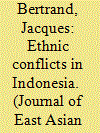

|
|
|
|
|
| Publication |
2008.
|
| Summary/Abstract |
Beginning in the mid-1990s, there was a sudden rise in violent ethnic conflict in Indonesia. Two aspects that require explanation are the timing and clustering of this type of conflict historically. Other studies have not adequately explained these aspects. Methodological and thematic choices have generated problems with identifying and explaining clustering. Microlevel studies fail to account for the broader changes occurring at a macrolevel. Some researchers have chosen to broaden the scope of analysis of violent events to provide explanations of violence more generally. After reviewing these other studies, I argue that a historical institutionalist approach remains best able to explain the clustering of conflicts and the following period of stability. Changing institutional contexts at critical junctures created rising anxieties as well as opportunities to renegotiate group inclusion and status in the Indonesian state.
|
|
|
|
|
|
|
|
|
|
|
|
|
|
|
|
| 2 |
ID:
084040
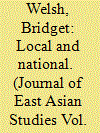

|
|
|
|
|
| Publication |
2008.
|
| Summary/Abstract |
From horrific accounts of men decapitated to "ordinary" accounts of stolen motorcycles, the routine beating and killing of alleged criminals by mobs (massa) has become common in Indonesia. This article examines the patterns of keroyokan-mobbing-from 1995 through 2004 in four provinces and highlights the temporal, spatial, and substantive variations of this phenomenon. Drawing from a database of provincial and local news clippings in Bali, Bengkulu, West Java, and South Kalimantan and in-depth case studies and interviews, this article shows that mobbing varies considerably. Its causes are national and local. The temporal data show that nationally the most important factor to influence levels of mobbing was the introduction of decentralization. The power vacuum that resulted from the policy decision to transfer authority from the center to localities increased local violence. Yet this macrolevel explanation is inadequate to show the spatial variation and different forms of mobbing violence. To understand the causes of these dimensions of variation, one has to move away from macronational approaches measuring violence and include a more microethnographic local approach. A richer understanding of mobbing must be locally rooted. This article uses three case studies to illustrate the centrality of local factors affecting this form of violence. The case studies suggest that mobbing is shaped by the acquiescence of actors in local communities and local learning. The article draws attention to the need to incorporate local data and methods into an analysis of violence in Indonesia and to appreciate varied daily rituals of violence as reservoirs of conflict.
|
|
|
|
|
|
|
|
|
|
|
|
|
|
|
|
| 3 |
ID:
117140
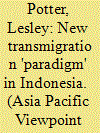

|
|
|
|
|
| Publication |
2012.
|
| Summary/Abstract |
Transmigration from Java to rural areas of the 'outer islands' appeared finished in Indonesia after the fall of the Suharto regime in 1998 and decentralisation in 2001. However, the rapid growth of oil palm plantations in the past decade has led to a renewed call for transmigrants by district heads seeking an expanded labour force. A new system has evolved on a district-to-district basis with applicants in 'sending districts' (in Java, Bali and the poorer provinces of East and West Nusa Tenggara) being matched to requests from 'receiving districts' (in Sumatra, Kalimantan, Sulawesi and Papua), which largely depend on levels of plantation investment near proposed new transmigration sites. Coordination is in the hands of a rebranded central Ministry of Manpower and Transmigration. Integral to the 'spatial' organisation of the new transmigration will be the creation of towns or cities, known as KotaTerpadu Mandiri ('Integrated self-sufficient city'). A new transmigration region (with its oil palm plantations) will form the 'embryo' for the city's growth. Although these arrangements will aim to reduce poverty, their social and environmental costs have not been evaluated. Examples of these new schemes in parts of Central Kalimantan are discussed, with brief comparisons of earlier transmigration projects.
|
|
|
|
|
|
|
|
|
|
|
|
|
|
|
|
| 4 |
ID:
178402
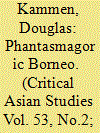

|
|
|
|
|
| Summary/Abstract |
The island of Borneo has been the subject of starkly different portrayals. On the one hand, the devastation of the island’s great rainforests, choking haze from fires set to clear land for oil palm plantations, and open-pit coal mining have prompted visions of environmental collapse. On the other hand, Indonesian President Joko Widodo’s 2019 announcement that the national capital will be moved from Jakarta to East Kalimantan prompted utopian dreams that massive investment and technology will create a glorious future. This article explores how these competing portrayals of Borneo emerged historically through European and American fiction – including utopian novels, lost race stories, and pulp and science fiction – and are reflected and reproduced in Indonesian political thinking. The final section examines how these long-standing ideas about Borneo as the site of the fantastic and the phantasmagoric have colored media reporting and commentary about President Widodo’s planned new capital in East Kalimantan.
|
|
|
|
|
|
|
|
|
|
|
|
|
|
|
|
| 5 |
ID:
163240
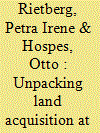

|
|
|
|
|
| Summary/Abstract |
Very few studies have captured the full complexity of land acquisition processes at the agricultural frontier. Specifically, the different stages in the land acquisition process and the changing responses of local communities to plantation development have not been adequately described and explained. Based on a detailed empirical case study of a land acquisition process in a village at the oil palm frontier in West Kalimantan, Indonesia, we address this knowledge gap. To comprehensively capture reactions ‘from below’ to large‐scale land acquisition, we use the interlinked concepts of access, property and authority. We show that the land acquisition process is basically a process of transforming and obscuring customary property rights and local authority. In our case, this process is characterised by an initial recognition of customary rights and local authority by the oil palm company. However, in the course of the process, these property rights and local authority are being transformed and eventually obscured. We call for a more interventionist state to prepare a less uneven playing field at the very beginning of land acquisition processes. This could slow down the nearly irrevocable obfuscation of customary rights and the erosion of local authority at the oil palm frontier.
|
|
|
|
|
|
|
|
|
|
|
|
|
|
|
|
|
|
|
|
|